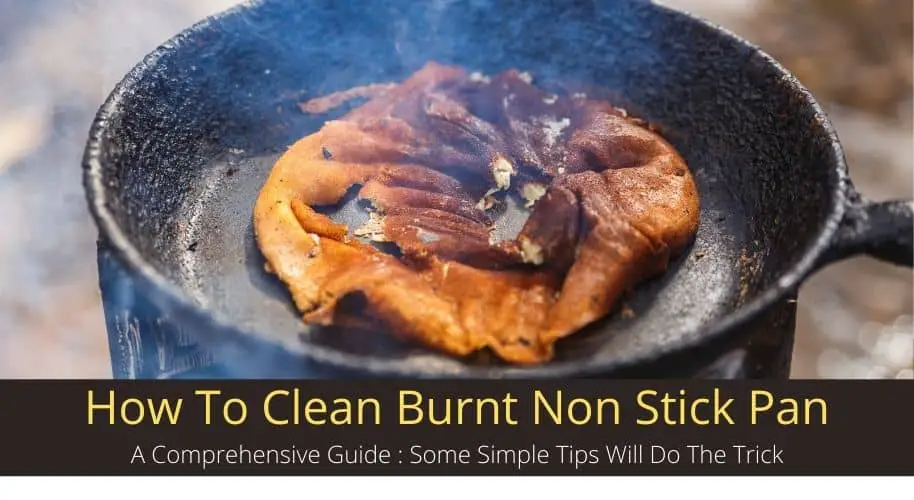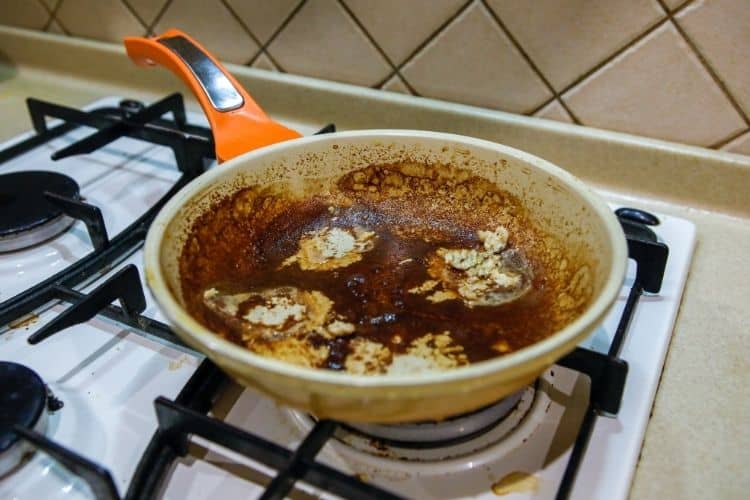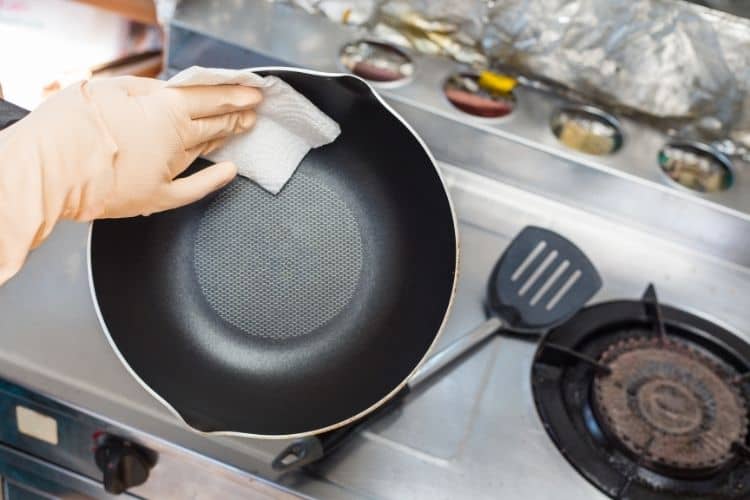Non stick pans are a great invention for any kitchen. They allow you to cook with less oil, and they’re easy to clean too. However, it’s important that you know how to clean a burnt non stick pan in case of an emergency with all these benefits. If you’ve ever had to deal with this issue, you know it can be difficult and time-consuming – not to mention frustrating. So what’s the secret? I’ve shared here a very simple but effective tip to clean a burnt non stick pan. Let’s check it out!

What are the things you need to clean a burnt non stick pan?
Here is what you need:
- A good amount of water
- Dish soap
- Nylon sponge
- Paper towels
- A pot of boiling water
Cleaning a burnt non stick pan:
1) Place the burnt pan into the kitchen sink and pour some hot water over the burnt surface.
2) Let it soak for 5-10 minutes to loosen and remove stuck food particles.
3) Then gently scrub with a nylon pad using soap or dishwashing liquid. (I recommend using dishwashing liquid or cleanser made especially for nonstick cookware instead of harsh detergent).
4) Rinse well in cold water to remove any residue that remains on the surface. Repeat the previous process if necessary.
4.) Dry your finished product using a paper towel to avoid any moisture spots accumulated later when stored in cabinet shelves or drawers.
How Does A Non Stick Pan Burn?

There are many ways that non stick pans can end up burning, but most often, they occur when someone cooks over high heat with oils or fats without having enough cooking liquid nearby – especially during frying foods like eggs and bacon, where grease may be more prevalent.
Non-stick pans are not high heat resistant. They can withstand a maximum temperature of 300 to 400 degrees Fahrenheit. However, the top high heat non stick pan has been evaluated by our experts at Easy Kitchen Guide. For additional inspiration, you can follow the link!
How to Prevent Non Stick Pan from Burning?
To prevent non stick pans from burning, one must avoid transferring too much heat into them when cooking over high temperatures without proper precautions like a splash of water nearby.
There are also other techniques that you can use such as lowering the stove’s temperature during frying foods – especially those with higher levels of grease or oils present: preferably below medium-high level; periodically stirring up any items that are being cooked; and poking around the sides of pots with wooden utensils to get a feel for where more grease or oils may be present.
However, here are some tips to prevent non stick pan from burning:
Never use metal utensils with your non stick pans:
If you use a metal utensil to stir, this will scratch the surface and make it more difficult for food to release from the pan.
Don’t let your food boil without stirring:
If you don’t work with the cooking process by stirring food as it boils or cooks in water, burnt bits of food can cling onto one another and create an unpleasant crust on the bottom of your pot.
Use low heat whenever possible:
Try using low heat when boiling liquids so that they cook at a slower pace and allow steam to escape from its top layer before reaching a rolling boil which usually causes scorching on the bottom of pots.
Keep a lid nearby while cooking any type of soup:
Lids trap moisture inside them as the heat rises from the pot, and this will prevent liquid from boiling all over your stove.
Keep a close eye on what you’re cooking:
Don’t walk away while food is simmering or frying because these types of foods must be stirred periodically to ensure that they cook evenly without burning.
Drop some water in there:
If you’re using any type of oil or fat, then use this technique by adding enough liquid so that it just covers the bottom layer of food and then place on low stovetop temperature. This will help keep burn marks off pots while reducing their risk for sticking.”
The tips we suggested are good to start if you want to prevent your nonstick pans from burning. You can also learn how to fix scratches in non stick pans by following this link.
However, if these ideas don’t help, it may be time for new cookware!
What You Should Avoid When Cleaning A Nonstick Pan

Nonstick pans are a blessing when it comes to cooking, but they can be a curse if you don’t know what you should avoid when cleaning a non stick pan. Because these will ruin your non stick pan. Here are the things to avoid:
Don’t put the pan in a dishwasher:
You should avoid the dishwasher and any harsh detergents when cleaning a nonstick pan because these will degrade the surface of your piece. Even if the manufacturer says it is dishwasher safe, it is best to avoid putting it there.
Don’t use a scouring pad, steel wool, or any abrasive cleaners:
These will scratch the surface and make it more difficult to clean. Instead, when cleaning, try using a soft sponge or dish detergent with water and a little vinegar.
Keep your pan clean by washing it after use:
You should not leave the dirty pan for cleaning the next day. If you leave it there, it will take longer and be harder to clean off later on.
The wrap up:
Thanks for the complete guide about how to clean a burnt non stick pan. We hope you’ve found this guide helpful and informative. To sum up, we just want to mention that cleaning a burnt non stick pan is not as hard or time-consuming as you might think. With the simple steps outlined in this blog post, it can be an easy task that will leave your kitchen looking shiny and new! Be sure to visit our website for more information on how to clean other types of pans. Remember, scrubbing with hot water and dish soap should do the trick without damaging the coating too much when all else fails!
My name is Lori Walker. I’m a registered dietitian, food blogger and food enthusiast. I share easy healthy, delicious recipes on my blog and review necessary kitchen items. The recipes I share take less… Read more
